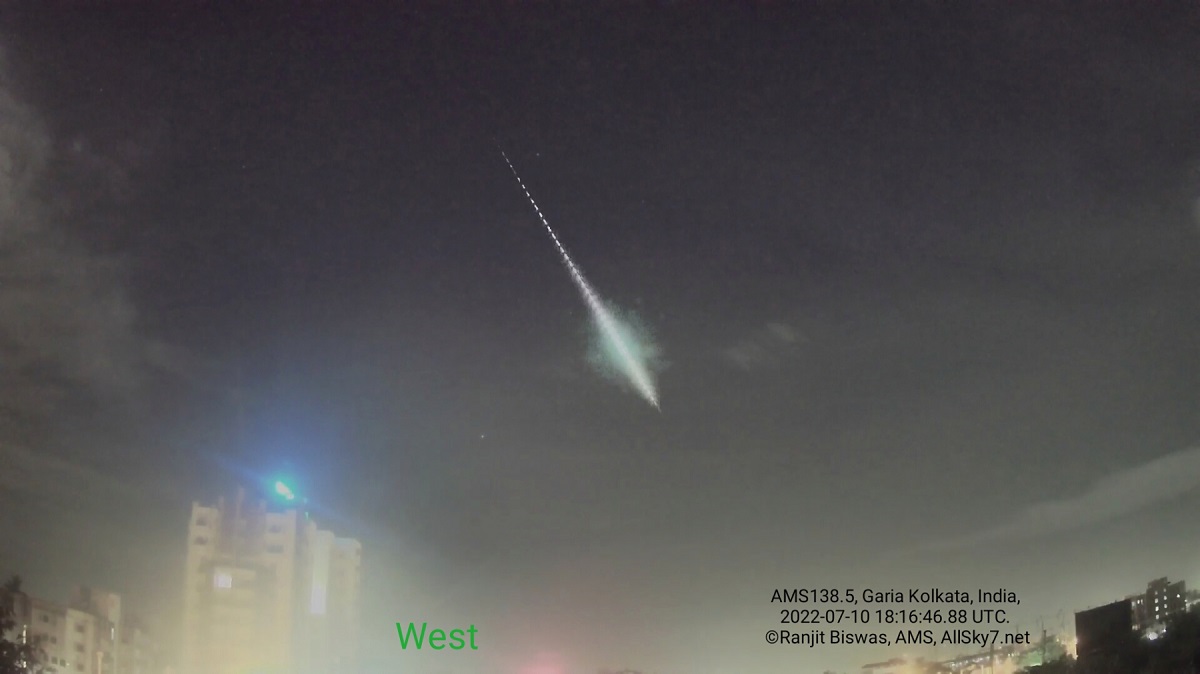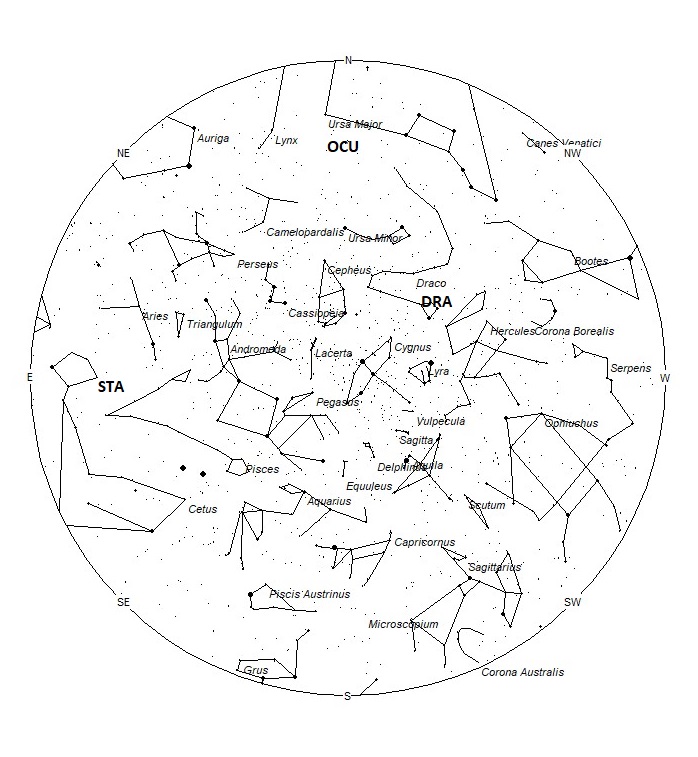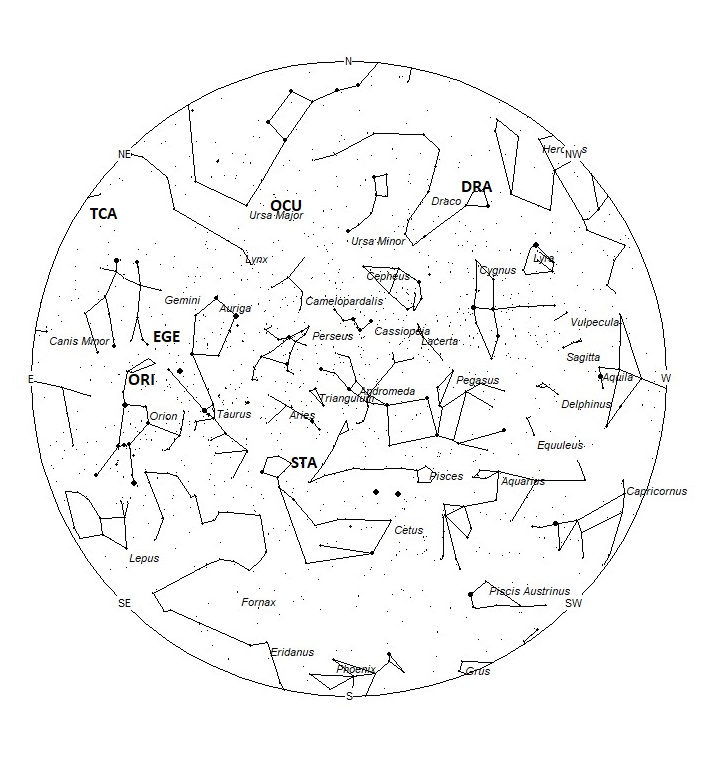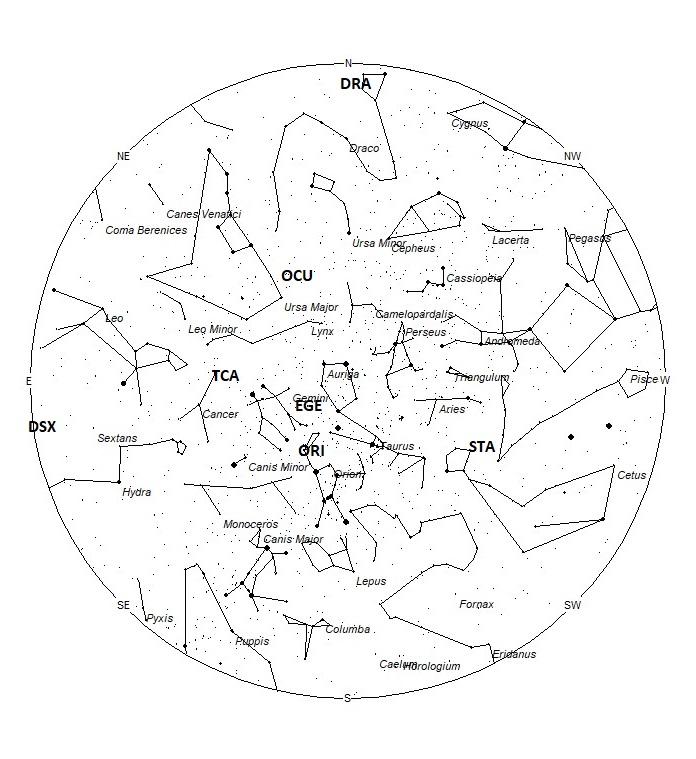 Ranjit Biswas captured this brilliant fireball using his AllSky Camera System on July 10, 2022, at 23:47 IST (18:17 UT) from Garia, Kolkata, India. Observers from India are reporting fireballs in ever increasing numbers. We welcome these reports and look forward to more reports and photographs from this part of the world! ©Ranjit Biswas
Ranjit Biswas captured this brilliant fireball using his AllSky Camera System on July 10, 2022, at 23:47 IST (18:17 UT) from Garia, Kolkata, India. Observers from India are reporting fireballs in ever increasing numbers. We welcome these reports and look forward to more reports and photographs from this part of the world! ©Ranjit Biswas
During this period, the moon reaches its full phase on Sunday October 9th. At that time the moon will lie opposite the sun and will lie above the horizon all night long. As the week progresses the waning gibbous moon will rise later each evening, allowing a window of opportunity to observe meteor activity in dark skies between dusk and moon rise. The estimated total hourly rates for evening observers this week should be near 3 as seen from mid-northern latitudes (45N) and 2 as seen from tropical southern locations (25S) For morning observers, the estimated total hourly rates should be near 7 as seen from mid-northern latitudes (45N) and 6 as seen from tropical southern locations (25S). The actual rates will also depend on factors such as personal light and motion perception, local weather conditions, alertness, and experience in watching meteor activity. Rates are reduced this week due to interfering moonlight. Note that the hourly rates listed below are estimates as viewed from dark sky sites away from urban light sources. Observers viewing from urban areas will see less activity as only the brighter meteors will be visible from such locations.
The radiant (the area of the sky where meteors appear to shoot from) positions and rates listed below are exact for Saturday night/Sunday morning October 8/9. These positions do not change greatly day to day so the listed coordinates may be used during this entire period. Most star atlases (available at science stores and planetariums) will provide maps with grid lines of the celestial coordinates so that you may find out exactly where these positions are located in the sky. I have also included charts of the sky that display the radiant positions for evening, midnight, and morning. The center of each chart is the sky directly overhead at the appropriate hour. These charts are oriented for facing south but can be used for any direction by rotating the charts to the desired direction. A planisphere or computer planetarium program is also useful in showing the sky at any time of night on any date of the year. Activity from each radiant is best seen when it is positioned highest in the sky, either due north or south along the meridian, depending on your latitude. It must be remembered that meteor activity is rarely seen at the radiant position. Rather they shoot outwards from the radiant, so it is best to center your field of view so that the radiant lies at the edge and not the center. Viewing there will allow you to easily trace the path of each meteor back to the radiant (if it is a shower member) or in another direction if it is sporadic. Meteor activity is not seen from radiants that are located far below the horizon. The positions below are listed in a west to east manner in order of right ascension (celestial longitude). The positions listed first are located further west therefore are accessible earlier in the night while those listed further down the list rise later in the night.
These sources of meteoric activity are expected to be active this week.
Details of each source will return next week when observing conditions are more favorable.
You can keep track of the activity of these meteor showers as well as those beyond the limits of visual observing by visiting the NASA Meteor Shower Portal available at: https://meteorshowers.seti.org/ You can move the sky globe to see different areas of the sky. Colored dots indicate shower meteors while white dots indicate sporadic (random) activity. The large orange disk indicates the position of the sun so little activity will be seen in that area of the sky.
The list below offers the information in tabular form of the showers that I feel are within reach of the visual observer to discern. Hourly rates are often less than 1 but noting parameters such as the radiant distance and the elevation of each meteor, one can compute the probably of shower association. Most showers discovered by video means have rates less than 1 per night away from maximum, so these listed showers are not as weak as they seem. Rates and positions are exact for Saturday night/Sunday morning except where noted in the shower descriptions.
| SHOWER | DATE OF MAXIMUM ACTIVITY | CELESTIAL POSITION | ENTRY VELOCITY | CULMINATION | HOURLY RATE | CLASS |
| RA (RA in Deg.) DEC | Km/Sec | Local Daylight Saving Time | North-South | |||
| Draconids (DRA) | Oct 08 | 17:32 (263) +56 | 21 | 17:00 | <1 – <1 | III |
| Southern Taurids (STA) | Oct 17 | 02:10 (033) +09 | 29 | 02:00 | 1 – 1 | II |
| Orionids (ORI) | Oct 21 | 05:45 (086) +15 | 67 | 06:00 | 1 – 1 | I |
| epsilon Geminids (EGE) | Oct 19 | 06:12 (093) +29 | 69 | 06:00 | <1 – <1 | II |
| A Carinids (CRN) | Oct 14 | 06:27 (099) -54 | 32 | 06:00 | <1 – <1 | IV |
| tau Cancrids (TCA) | Oct 20 | 08:29 (127) +30 | 67 | 08:00 | <1 – <1 | IV |
| October Ursa Majorids (OCU) | Oct 16 | 08:38 (130) +67 | 57 | 08:00 | <1 – <1 | IV |
| Daytime Sextantids (DSX) | Oct 03 | 10:50 (163) -05 | 31 | 10:00 | <1 – <1 | IV |
Class Explanation: A scale to group meteor showers by their intensity:
- Class I: the strongest annual showers with Zenith Hourly Rates’s normally ten or better.
- Class II: reliable minor showers with ZHR’s normally two to ten.
- Class III: showers that do not provide annual activity. These showers are rarely active yet have the potential to produce a major display on occasion.
- Class IV: weak minor showers with ZHR’s rarely exceeding two. The study of these showers is best left to experienced observers who use plotting and angular velocity estimates to determine shower association. These weak showers are also good targets for video and photographic work. Observers with less experience are urged to limit their shower associations to showers with a rating of I to III.
 American Meteor Society
American Meteor Society



My husband and I witnesses a meteor on Saturday evening, October 8 around 8:15 pm over our neighborhood in Ballston Lake, NY. It was spectacular – bright green in color with a yellow fire tail that shot across the sky and then vanished. This was part of a beautiful full-moon lit sky. Our first sightening of something of this kind.
Last night, Oct 12 at 10:15ish over Portland Oregon. I was nearly asleep, laying in bed facing the window and the brightest light flashed and my mind instinctively thought it was the headlights of a truck, then I thought that didn’t make sense coming from the sky. Opened my eyes to see what looked like maybe an asteroid ♂️ It was SO bright maybe hitting the earth’s atmosphere then a bright orange streak in the sky. Then gone quickly. I don’t know enough to say what it was and I can’t find any news about it today. Curious if you would know details.
I witnessed an orange fireball streak across the sky heading in a southeast direction near the Wayne County/Johnson County line near Pikeville, NC, approximately 5:10 a.m. EST on October 14, 2022.